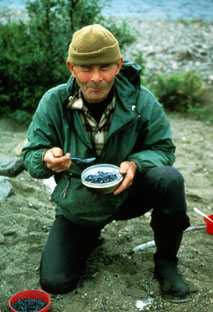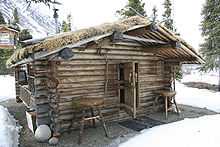Richard Proenneke
| Richard Proenneke | |
|---|---|
 A photograph of Proenneke while in Twin Lakes. | |
| Born |
Richard Louis Proenneke May 4, 1916 Primrose, Harrison Township, Lee County, Iowa |
| Died |
April 20, 2003 (aged 86) Hemet, Riverside County, California |
Cause of death | Stroke |
| Residence | Twin Lakes, Alaska |
| Nationality | American |
| Occupation | Naturalist, carpenter, mechanic |
| Awards | 1999 National Outdoor Book Award (NOBA) |
Richard Louis "Dick" Proenneke (May 4, 1916 – April 20, 2003) was an American naturalist who lived alone in the high mountains of Alaska at a place called Twin Lakes. Living simply in a log cabin he constructed by hand, Proenneke made valuable recordings of both meteorological and natural data.[1]
Life
Proenneke's father, William Christian Proenneke, served in World War I and later made his living as a well driller. His mother, Laura (née Bonn) was a homemaker. His parents married in late 1909, or early 1910, and had three daughters and three sons: Robert, Helen, Lorene, Richard (Dick), Florence, and Raymond (Jake). The year of Richard's birth is often given as 1917, but social security and census records prove him to have been born in Primrose, Harrison Township, Lee County, Iowa, on May 4, 1916.
Proenneke served in the United States Navy as a carpenter during World War II. It was during this service that he contracted rheumatic fever and was bedridden for nearly six months.[1] According to Sam Keith, a lifelong friend from Duxbury, Massachusetts, this illness was very revealing for Proenneke, who decided to devote the rest of his life to the strength and health of his body.
Following his discharge from the Navy, Proenneke went to school to become a diesel mechanic. The combination of his high intelligence, adaptability, and strong work ethic turned him into a very skilled mechanic. Though quite adept at his trade, Proenneke yielded to his love of nature and moved to Oregon to work at a sheep ranch. He moved to Shuyak Island, Alaska, in 1950.
For several years, he worked as a heavy equipment operator and repairman on the Naval Air Station at Kodiak. Proenneke spent the next several years working throughout Alaska as both a salmon fisherman and diesel mechanic. He worked for the Fish and Wildlife Service at King Salmon on the Alaska Peninsula. His skills as a mechanic were well-known and extremely sought after, and he was able to put away a modest nest egg for retirement. Proenneke retired to Twin Lakes.
Retirement

On May 21, 1968, Proenneke arrived at his new place of retirement at Twin Lakes. Beforehand, he made arrangements to use a cabin on the upper lake of Twin Lakes owned by retired Navy captain Spike Carrithers and his wife Hope of Kodiak (in whose care he had left his camper). This cabin was well situated on the lake and close to the site which Proenneke chose for the construction of his own cabin.
The cabin is hand-made. Proenneke's talents as a carpenter are visible — the entire structure was made from materials in and about the site, from the gravel taken from the lake bed to create the cabin's base, to the trees he selected, cut down, and then hand-cut into interlocking joints to create the walls and roof rafter framing. The window openings were pre-planned and cut to suit. The fireplace and flue were made from stones he dug from around the site and then meticulously placed to create the chimney and hearth. He used metal containers for food storage — one-gallon cans were cut into basin shapes and buried below the frost line. This ensured that fruits and perishables could be stored for prolonged periods in the cool earth yet still be accessible when the winter months froze the ground above them. Proenneke's friend, bush pilot and missionary Leon Reid "Babe" Alsworth, returned occasionally to bring food and orders that Proenneke placed through him to Sears.
Proenneke remained at Twin Lakes for the next 16 months, when he left to go home for a time to visit relatives and secure more supplies. He returned to the lakes in the following spring and remained there for most of the next 30 years, going to the Continental US only occasionally to be with his family. He made a film record of his solitary life which was later recut and made into the documentary Alone in the Wilderness. It has aired on PBS numerous times. In 2011 a sequel was produced after it was discovered that Proenneke had shot enough footage for at least two more programs. Alone in the Wilderness: Part 2 premiered on December 2, 2011. A premiere date for Part 3 has yet to be announced.
Death and legacy
In 1999, at age 82, Proenneke returned to civilization and lived the remainder of his life with his brother Raymond "Jake" Proenneke in Hemet, California. He died of a stroke April 20, 2003 at the age of 86. He left his cabin to the National Park Service, and it remains a popular visitor attraction in the still-remote Twin Lakes region.
Sam Keith, who got to know Proenneke at the Kodiak Naval Station and went on numerous hunting and fishing trips with him, suggested that Proenneke's journals might be the basis for a good book. Proenneke agreed to whatever changes Keith wanted to make.[2] In 1973, Keith published the book One Man's Wilderness: An Alaskan Odyssey, based on Proenneke's journals and photography. After years in print it was re-issued in a new format in 1999, winning that year's National Outdoor Book Award (NOBA).[3] A hardcover "commemorative edition", celebrating the fortieth anniversary of the publication of One Man's Wilderness, was published by Alaska Northwest Books in 2013. In 2003, some of the copyrighted text from the book and some of Proenneke's film were used with permission in Alone in the Wilderness,[4] which began appearing on U.S. Public Television. The documentary centers around Proenneke building a cabin from the surrounding natural resources and includes his film footage and narration of wildlife, weather, and the natural scenery while he goes about his daily routine over the course of the winter months.
In 2005, the National Park Service and the Alaska Natural History Association published More Readings From One Man's Wilderness, another volume of Proenneke's journal entries. The book, edited by John Branson, a longtime Lake Clark National Park employee and friend of Proenneke, covers the years when the park was established. Dick had a very close relationship with the Park Service, assisting them in filming sensitive areas and notifying them if poachers were in the area.
The Early Years: The Journals of Richard L. Proenneke 1967-1973 was published by Alaska Geographic in 2010. As with More Readings From One Man's Wilderness, the volume is edited by John Branson. This collection of journals covers Proennekes' first years at Twin Lakes, including the construction of his cabin and cache. The journal entries overlap those in Sam Keith's edited collection of some of Proenneke's journals One Man's Wilderness: An Alaskan Odyssey. But unlike that book—in which Keith frequently modified Proenneke's writing style--The Early Years presents Proenneke's journals with minimal or no modification.
See also
- Dan O'Neill (writer)
- Velma Wallis
- Carl McCunn, wildlife photographer who became stranded in the Alaskan wilderness and eventually committed suicide when he ran out of supplies (1981)
- Coming into the Country, a 1976 book documenting travels through Alaska
- Nanook of the North, 1922 silent film documentary following the lives of an Inuit family
- Ed Wardle, documented his solo wilderness adventure in the 2009 television series Alone in the Wild
- Christopher McCandless, subject of Jon Krakauer’s book Into the Wild, later adapted into a film by Sean Penn (2007)
- Everett Ruess, disappeared in the Utah wilderness in 1934
References
- ↑ 1.0 1.1 Branson, John (2006). More Readings From One Man's Wilderness, The journals of Richard L. Proenneke 1974-1980. National Park Service.
- ↑ "I wrote them (Bob Henning, way last year) saying that it was my request that you be the author." —letter from Richard Proenneke to Sam Keith, dated Feb. 13, 1973
- ↑ "Winners of the 1999 National Outdoor Book Awards". National Outdoor Book Awards Foundation. Retrieved 16 March 2013.
- ↑ Alone in the Wilderness, the story of Dick Proenneke, by Bob Swerer Productions. Retrieved September 29, 2012.
Bibliography
- Branson, John B., ed. (2005) More Readings From One Man's Wilderness: The Journals of Richard L. Proenneke, 1974-1980, National Park Service, ISBN 9780930931780.
- Branson, John B., ed. (2010) The Early Years: The Journals of Richard L. Proenneke, 1967-1973, Alaska Geographic, ISBN 9780982576533.
- Proenneke, Richard and Sam Keith, ed. ([1973] 2013) , Alaska Northwest Books, ISBN 9780882409429.
External links
| Wikiquote has a collection of quotations related to: Richard Proenneke |
- Bio
- NPS page about Richard Proenneke
- Alone in the Wilderness at IMDB
- Photos of the landscape in Lake Clark National Park
- Map showing the location of Proenneke's cabin
- Lake Clark National Park Official Web Site
- A satellite view of Dick Proenneke's cabin and Twin Lakes
|